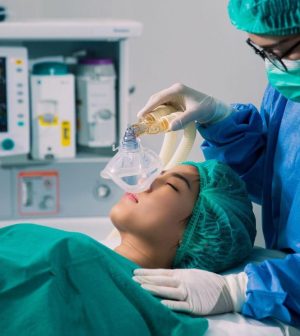- Understanding the Connection Between Anxiety and Depression
- How Daily Prunes Can Influence Cholesterol and Inflammation
- When to Take B12 for Better Absorption and Energy
- Epsom Salts: Health Benefits and Uses
- See What Saffron Can Do for Sleep and Heart Health
- 6 Common Mistakes to Avoid Before Your Physical
- Can Sweating Really Help You Beat a Cold?
- Strengthening Your Relationship: Practical Strategies
- Skip Storing This Everyday Product in the Fridge Door
- Green Tea + B3 Pairing May Boost Brain Health
Routine Ventilation of Surgical Patients Won’t Raise COVID Transmission Risk

Routine face mask ventilation during an operation doesn’t increase the surgical team’s risk of coronavirus infection, according to a new study.
Face mask ventilation is typically used for surgical patients under general anesthesia. However, its designation as an “aerosol-generating procedure” by the World Health Organization has altered operating room procedures and efficiency during the COVID-19 pandemic, the researchers explained.
Due to the designation, guidance changed for anesthetists performing face mask ventilation in a patient at risk of having COVID-19. They have to wear a respirator mask, eye protection and additional personal protective equipment, and the same goes for nearby members of the surgical team.
Also, up to half an hour per case is added to each operation to allow sufficient air changes in the operating room to ensure that all potentially infectious aerosol is gone.
These measures mean far fewer operations can be performed each day and contribute to backlogs in the entire health care system, lead author Dr. Andrew Shrimpton, of the University of Bristol in the United Kingdom, and colleagues reported.
To assess the need for such measures, the researchers monitored respiratory aerosol from anesthetized patients during standard face mask ventilation and face mask ventilation with an intentionally generated air leak. The leak was designed to mimic the worst-case scenario where aerosol might spread into the air.
Those findings were compared to aerosol from patients’ normal breathing and coughing.
Median aerosol concentrations were 191 particles per liter through normal breathing, 3 particles per liter during face mask ventilation without a leak and 11 particles per liter during intentional face mask leak.
That means that compared to normal breathing, levels were 64 times lower with face mask ventilation without a leak and 17 times lower with the intentional face mask leak, according to the study. The results were published Oct. 26 in the journal Anaesthesia.
The researchers also found that peak particle concentrations were 1,260 particles per liter when a patient coughed, compared with 60 per liter (20 times lower) for regular face mask ventilation and 120 per liter (10 times lower) with an intentional face mask leak.
“This study demonstrates that face mask ventilation, even when performed with an intentional leak, does not generate high levels of bioaerosol,” Shrimpton said in a journal news release.
“The low concentration of aerosol detected during face mask ventilation even with an intentional leak is also reassuring given that this represents a worst-case scenario. Both normal breathing and a voluntary cough generate many-fold higher quantities of aerosol than face mask ventilation,” according to Shrimpton and his team.
On this basis, they said, face mask ventilation should not be considered an aerosol-generating procedure.
“Accumulating evidence demonstrates many procedures currently defined as aerosol-generating are not intrinsically high risk for generating aerosol, and that natural patient respiratory events often generate far higher amounts,” the study authors concluded.
More information
The American College of Surgeons has more on surgery and COVID-19.
SOURCE: Anaesthesia, news release, Oct. 26, 2021
Source: HealthDay
Copyright © 2026 HealthDay. All rights reserved.










